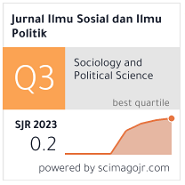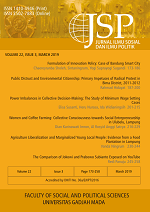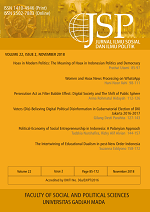Impact of the US-China Trade War on Foreign Trade of Emerging Economies: Brazil, South Africa, and Indonesia
Andi Kurniawan(1*), Khoirur Rizal Luthfi(2)
(1) International Relations Department, Universitas Pembangunan Nasional Veteran Jakarta, Indonesia
(2) International Law, Faculty of Law, Universitas Pembangunan Nasional Veteran Jakarta, Indonesia
(*) Corresponding Author
Abstract
The study analyses the potential impacts of the US-China trade war on the foreign trade of emerging economies, i.e., Indonesia, Brazil, and South Africa, and their foreign economic policies to obtain alternative markets outside the US and China. These countries were chosen because they have similar industrial characteristics and robust commercial relationships with the US and China. This study uses desk review approach and secondary data analysis from the International Trade Center (ITC) Database, the WTO Tariff Database, and the Peterson Institute of International Economics (PIIE). The impacts were portrayed in several views: triangular trade structure, global value chain, China+1, and Global South relationship. In the context of a triangular trade structure with China as the mediator, Indonesia’s and Brazil's trade was relatively secure since they exported considerable natural resources to China. At the same time, they could maintain positive trade performance with the US and China owing to the global value chain. South Africa has extensive imports of intermediate goods from the US and China, mainly for the automotive sector and further processed for the African market. However, since the significant position of the US as a trading partner, Indonesia, Brazil, and South Africa were potentially exposed to protectionism behavior. Indonesia benefits significantly from the US General System Preferences (GSP) trade facilities for developing countries. The consistent trade surplus has raised critical concerns from the US government regarding Indonesian exports. Therefore, the escalation has also enhanced cooperation in the Global South, including the Brazil-led Mercosur free trade negotiation with Singapore and Indonesia's preferential trade agreement with Pakistan and Bangladesh.
Keywords
Full Text:
PDFReferences
Abrar, M. (2021, October 21). South Africa set to take trade with Pakistan to $2bn mark: Says envoy. Pakistan Today. https://profit. pakistantoday.com.pk/2021/10/21/south- africa-set-to-take-trade-with-pakistan-to-2bn-mark-says-envoy/
Agarwal, V., & Golley, J. (2022). Do political relations affect exports to China? Evidence from the ‘Quad.’ The World Economy, twec.13252. https://doi.org/10.1111/ twec.13252
Al Farisi, S. (2019, September 5). Indonesia and South Africa: Solidarity that seeks shared prosperity. The Jakarta Post. https://www.thejak artapost.com/academia/2019/09/05/indonesia-and-south-africa-solidarity-that-seeks- shared-prosperity.html
Amorim, S. C., & Ferreira-Pereira, L. C. (2021). Brazil’s quest for autonomy in Asia: The role of strategic partnerships with China and Japan. Revista Brasileira de Política Internacional, 64(2), e003. https://doi. org/10.1590/0034-7329202100203
Arif Khan, A. (2021). Pakistan’s Engage Africa Policy and the Future of Pak-Afro Ties. The Centre for Strategic and Contemporary Research (CSCR). https://cscr.pk/explore/ themes/trade-economics/pakistans-engage-africa-policy-and-the-future-of- pak-afro-ties/
Bahmani-Oskooee, M., & Gelan, A. (2019). The South Africa-U.S. Trade And the Real Exchange Rate: Asymmetric Evidence from 25 Industries. South African Journal of Economics, 1–18. https://doi.org/10.1111/saje.12242
Balaam, D. N., & Dillman, B. (2019). Introduction to International Political Economy (Seventh). Routledge.
Bam, W. G., De Bruyne, K., & Laing, M. (2021). The IO–PS in the context of GVC-related policymaking: The case of the South African automotive industry. Journal of International Business Policy, 4(3), 410–432. https://doi.org/10.1057/s42214-020-00081-7
Blackwill, R. D. (2020). A WORK PLAN Twenty- Two U.S. Policy Prescriptions to Implement U.S. Grand Strategy Tow ard China (Implementing Grand Strategy Toward China). Council on Foreign Relations.
Bown, C. P. (2021a). 21-2 The US-China Trade War and Phase One Agreement. Working Paper Series-Peterson Institute of International Economics, 57.
Bown, C. P. (2021b). The US–China trade war and Phase One agreement. Journal of Policy Modeling, 43(4), 805–843. https:// doi.org/10.1016/j.jpolmod.2021.02.009
Bradley, A. (2016). China and South Africa: Emerging Powers in an Uncomfortable Embrace. Journal of Contemporary China, 25(102), 881–892. https://doi.org/10.1080/10670564.2016.1184900
Brennan, L., & Rakhmatullin, R. (2017). Chapter 11—Transnationalizing Smart Specialization Strategy. In Advances in the Theory and Practice of Smart Specialization. Elsevier.
Chong, T. T. L., & Li, X. (2019). Understanding the China–US trade war: Causes, economic impact, and the worst-case scenario. Economic and Political Studies, 7(2), 185–202. https://doi.org/10.1080/20954816.2019.1595328
Cook, N. (2020). South Africa: Current Issues, Economy, and U.S. Relations. Congressional Research Service (CRS) Report, 38.
Cooper, A. F., & Pouliot, V. (2015). How much is global governance changing? The G20 as international practice. Cooperation and Conflict, 50(3), 334–350. https://doi.org/10.1177/0010836715576007
Cui, F., & Liu, G. (2019). Global value chains and production networks: Case studies of Siemens and Huawei. Academic Press ; Social Sciences Academic Press (China).
Dent, C. M. (2020). Brexit, Trump and trade: Back to a late 19th century future? Competition & Change, 24(3–4), 338–357. https://doi.org/10.1177/1024529420921481
Douch, M. (2020). The effect of policy uncertainty on South Africa, SADC, and beyond. UNU WIDER Working Paper, 59. https://doi. org/10.35188/UNU-WIDER/2020/816-0
Eichengreen, B. (2020). Why hasn’t the impact of the trade war been greater? Journal of Policy Modeling, 42(4), 820–828. https://doi.org/10.1016/j.jpolmod.2020.03.007
Elms, D. (2021). Trade Disrupted: Global Tensions, US-China Trade War and COVID-19 Impact. Southeast Asian Affairs, 15.
Guerin, B., Janta, B., & Van Gorp, A. (2018). In J. Hofman & A. Sutherland (Eds.), Evaluating interventions that prevent or counter violent extremism: A practical guide. RAND Corporation. https://doi.org/10.7249/ RR2094
Gusarova, S. (2019). Role of China in the development of trade and FDI cooperation with BRICS countries. China Economic Review, 57, 101271. https://doi.org/10.1016/j.chieco.2019.01.010
Haenle, P. (2019). The United States and China See Things Differently. Can They Reachan Understanding? Carnegie Endowment for International Peace. https://carnegieendowment.org/2019/12/18/united-states-and-china-see-things-differently.-can-they-reach-understanding- pub-80626
Harris, B. (2020, January 18). Brazilian exports could sustain $10bn hit from US-China trade truce. Financial Times. https://www. ft.com/content/6f48b414-3923-11ea-a6d3-9a26f8c3cba4
He, R., Zhu, D., Chen, X., Cao, Y., Chen, Y., & Wang, X. (2019). How the trade barrier changes environmental costs of agricultural production: An implication derived from China’s demand for soybean caused by the US-China trade war. Journal of Cleaner Production, 227, 578–588. https://doi.org/10.1016/j.jclepro.2019.04.192
Heydarian, R. J. (2023, September 5). Stage set for a disagreeable ASEAN summit in Jakarta. Asia Times. https://asiatimes. com/2023/09/stage-set-for-a-disagreeable- asean-summit-in-jakarta/
Hopewell, K. (2015). Different paths to power: The rise of Brazil, India and China at the World Trade Organization. Review of International Political Economy, 22(2), 311–338. https://doi. org/10.1080/09692290.2014.927387
Hopewell, K. (2022). Beyond U.S.-China Rivalry: Rule Breaking, Economic Coercion, and the Weaponization of Trade. AJIL Unbound, 116, 58–63. https://doi.org/10.1017/aju.2022.3
Isono, I., & Kumagai, S. (2023). ASEAN’s Role in the Threat of Global Economic Decoupling: Implications from Geographical Simulation Analysis. ERIA Policy Brief, 2022–10. https://www.eria.org/uploads/media/policy-brief/ FY2022/ASEAN%E2%80%99s-Role-in-the- Threat-of-Global-Economic-Decoupling- Implications-from-Geographical- Simulation-Analysis..pdf
ITC Trade Map. (2022). International Trade Centre (ITC) Trade Map—Trade Statistics for International Business Development [Statistical Database of International Organization]. ITC Trade Map. https:// www.trademap.org/Index.aspx
Juventia, D. C., Choirulina, E., & Anggrainy, Y. A. (2019). The Economic Impact of Indonesia- Bangladesh Preferential Trade Agreement. Proceedings of the International Conference on Trade 2019 (ICOT 2019). Proceedings of the International Conference on Trade 2019 (ICOT 2019), Cikini, Indonesia. https://doi. org/10.2991/icot-19.2019.8
Kausikan, B. (2019). ASEAN and US-China Competition (CSCAP Regional Security Outlook + ARF-The next 25 Years 2019, pp. 37–41). Council for Security Cooperation in the Asia Pacific.
Kawanami, T., Harada, I., & Fang, A. (2020, January 16). US and China sign trade truce, with tougher phase of talks to come. Nikkei Asian Review . https://asia.nikkei.com/Economy/Trade-war/ US-and-China-sign-trade-truce-with- tougher-phase-of-talks-to-come
Kemendag. (2019, August 28). Indonesia- Mozambik PTA: Perjanjian Dagang Pertama Indonesia dengan Negara di Afrika [Go vernm ent Webs ite]. Direkto rat Jenderal Perundingan Perdagangan Internasional. https://ditjenppi. kemendag.go.id/index.php/berita/detail/indonesia-mozambik-pta-perjanjian- dagang-pertama-indonesia-dengan- negara-di-afrika
Kemendag. (2022a, April 28). Indonesia - Pakistan Preferential Trade Agreement (IP- PTA) [Government Website]. Direktorat Jenderal Perundingan Perdagangan Internasional. https://ditjenppi. kemendag.go.id/index.php/bilateral/ asia-selatan-tengah-dan-timur/pakistan
Kemendag. (2022b, April 28). Indonesia - Bangladesh Preferential Trade Agreement (IB-PTA) [Government Website]. Direktorat Jenderal Perundingan Perdagangan Internasional. https://ditjenppi.kemendag.go.id/index. php/bilateral/asia-selatan-tengah-dan- timur/bangladesh
Kimura, K. (2011). China and India’s Electrical and Electronics Industries: A Comparison between Market Structures. In M. Ohara, M. Vijayabaskar, & H. Lin (Eds.), Industrial Dynamics in China and India: Firms, clusters, and different growth paths. Palgrave Macmillan.
Kliman, D. M., & Fontaine, R. (2012). Global Swing States Brazil, India, Indonesia, Turkey and the Future of International Order. Center for a New American Security.
Kohnert, D. (2018). Trump’s Tariff’s Impact on Africa and the Ambiguous Role of African Agency. SSRN Electronic Journal. https://doi.org/10.2139/ssrn.3205221
Korgun, I. (2021). South Korea trade during COVID-19 pandemic: Perspectives on value chains and US-CHINA trade war. Asia and Africa Today, 2, 36. https://doi.org/10.31857/S032150750014002-4
Kuroiwa, I. (2014). Value added trade and structure of high-technology exports in China. Institute of Developing Economies (IDE-JETRO). https://doi.org/10.20561/00037721
Latin America News. (2021, July 13). Brazil & Mercosur should close trade deal with Asian wealth leader Singapore. The Rio Times. https://www.riotimesonline.com/ brazil-news/brazil/brazil-should-close-trade-deal-with-asian-wealth-leader- singapore/
le Pere, G. (2021). The Political Economy of South Africa–China Trade and Economic Relations. In C. Alden & Y.-S. Wu (Eds.), South Africa–China Relations (pp. 85–106). Springer International Publishing. https://doi.org/10.1007/978-3-030-54768-4_5
Lee, Y. (2018). Economic Interdependence and Peace: A Case Comparison Between the US-China and US-Japan Trade Disputes. East Asia. https://doi.org/10.1007/s12140-018-9298-1
Lekgoro, M. (2022, April 26). Việt Nam remains a true international partner to South Africa. Vietnam News. https://vietnamnews.vn/ opinion/1176149/viet-nam-remains-a-true-international-partner-to-south-africa.html
Li, M., Balistreri, E. J., & Zhang, W. (2020). The U.S.–China trade war: Tariff data and general equilibrium analysis. Journal of Asian Economics, 1–13. https://doi.org/10.1016/j.asieco.2020.101216
Liu, Y., Li, H., An, H., Santagata, R., Liu, X., & Ulgiati, S. (2021). Environmental and economic sustainability of key sectors in China’s steel industry chain: An application of the Emergy Accounting approach. Ecological Indicators, 129, 108011. https://doi. org/10.1016/j.ecolind.2021.108011
Maciejewska, A., Kuzak, Ł., Sobieraj, J., & Metelski, D. (2022). The Impact of Opencast Lignite Mining on Rural Development: A Literature Review and Selected Case Studies Using Desk Research, Panel Data and GIS-Based Analysis. Energies, 15(15), 5402. https://doi.org/10.3390/en15155402
Maphaka, D., & Shai, K. B. (2021). South Africa in China’s Foreign Policy towards Africa: An Afrocentric Analysis. 8(3), 16.
McIvor, R., & Bals, L. (2021). A multi-theory framework for understanding the reshoring decision. International Business Review, 30(6), 101827. https://doi.org/10.1016/j.ibusrev.2021.101827
Meyer, P. J. (2020). Brazil: Background and U.S. Relations. Congressional Research Service (CRS) Report, R46236, 29.
Nugroho, A., Widyastutik, Irawan, T., & Amaliah, S. (2021). Does the US–China trade war increase poverty in a developing country? A dynamic general equilibrium analysis for Indonesia. Economic Analysis and Policy, 71, 279–290. https://doi.org/10.1016/j.eap.2021.05.008
O’Brien, R., & Williams, M. (2020). Global Political Economy (6th Edition). Red Globe Press.
Olasehinde-Williams, G., & Oshodi, A. F. (2021). Global value chains and export growth in South Africa: Evidence from dynamic ARDL simulations. Transnational Corporations Review, 1–13. https://doi.org/10.1080/19186444.2021.1959833
Pangestu, M. (2019). China–US trade War: An Indonesian Perspective. China Economic Journal. https://doi.org/10.1080/17538963.2019.1611084
Parama, M. (2020, June 30). Seven companies to relocate facilities to Indonesia, invest $850m. The Jakarta Post. https://www.thejakartapost.com/news/2020/06/30/seven-companies-to-relocate-facilities-to- indonesia-invest-850m.html
Paszak, P. (2021). U.S.-China Trade War: Origins, Timeline and Consequences (p. 22). Warsaw Institute.
Pedroletti, D., & Ciabuschi, F. (2023). Reshoring: A review and research agenda. Journal of Business Research, 164, 114005. https://doi. org/10.1016/j.jbusres.2023.114005
Peine, E. K. (2020). Chinese investment in the Brazilian soybean sector: Navigating relations of private governance. Journal of Agrarian Change. https://doi.org/10.1111/joac.12391
Piatanesi, B., & Arauzo-Carod, J. (2019). Backshoring and nearshoring:An overview. Growth and Change, 50(3), 806–823. https://doi.org/10.1111/grow.12316
Polatay, S. S. (2020). Who Likes Cooperation? A Long-Term Analysis of the Trade War between the US, the EU and China. Uluslararasi Iliskiler, 17(67), 41–60. https://dx.doi.org/10.33458/uidergisi.772664
Reis, M., & Sampaio, D. (2019). Why Does Brazil Have a Small Participation in the Global Value Chains? An Analysis of the External Insertion of the Brazilian Economy. In E. C. Grivoyannis (Ed.), International Integration of the Brazilian Economy (pp. 289–323). Palgrave Macmillan US. https://doi.org/10.1057/978-1-137-46260-2_11
Ren, D. (2019, May 17). The US-China trade war has been a boon for Brazil’s soybean farmers. But can they keep up with Chinese demand? South China Morning Post. https://www.scmp.com/business/ companies/article/3010480/us-china- trade-w ar-has-been-boon-brazils-soybean-farmers-can
Robinson, S., & Thierfelder, K. (2019). Global adjustment to US disengagement from the world trading system. Journal of Policy Modeling, 41, 522–536. https://doi.org/10.1016/j.jpolmod.2019.03.019
Rosito, T., & de Carvalho, V. M. (2022). Brazil–China Trade Relations In search of a Strategy (01; POLICY SERIES 2022 China in the World, p. 18). LAU CHINA INSTITUTE_the Brazil Institute & the Brazilian Center for International Relations (CEBRI). https://www.kcl.ac.uk/lci/assets/ ksspplcipolicypaper0122-brazil-china- trade.pdf
Santos-Paulino, A. U. (2011). Trade specialization, export productivity and growth in Brazil, China, India, South Africa, and a cross section of countries. Economic Change and Restructuring, 44(1–2), 75–97. https://doi.org/10.1007/s10644-010-9087-3
Satake, M. (2000). Trade conflicts between Japan and the United States over market access: The case of automobiles and automotive parts. Pacific Economic Paper, 310.
Septiari, D. (2020, November 1). US extends GSP status for Indonesia. The Jakarta Post. https://www.thejakartapost.com/ news/2020/11/01/us-extends-gsp-status- for-indonesia.html
Singh, K. (2007). Quantitative social research methods. Sage Publications.
Steinbock, D. (2018). U.S.-China Trade War and Its Global Impacts. China Quarterly of International Strategic Studies, 04(04), 515–542. https://doi.org/10.1142/S2377740018500318
Sturgeon, T., Gereffi, G., Guinn, A., & Zylberberg, E. (2013). Brazil in Global Value Chains: Implications for Trade and Industrial Policy. Funcex Magazine, 16.
Suzuki, H. (2021). Building Resilient Global Supply Chains: The Geopolitics of the Indo-Pacific Region. Center for Strategic and International Studies, 8.
Thanh, N. D. (2021). Vietnam’s Economic Prospects in the Wake of the US-China Trade Conflict and COVID-19. Southeast Asian Affairs, 24.
Thorbecke, W., & Kato, A. (2021). How would a slowdown in the People’s Republic of China affect its trading partners? Asia and the Global Economy, 1(2), 100015. https:// doi.org/10.1016/j.aglobe.2021.100015
Urata, S. (2019). US–Japan Trade Frictions: The Past, the Present, and Implications for the US–China Trade War. Asian Economic Policy Review, 1–19. https://doi. org/10.1111/aepr.12279
Van Thiel, S. (2022). Research Methods in Public Administration and Public Management (Second). Routledge.
Venzon, C. (2022, September 21). Emerging Asia growing faster than China for 1st time in 30 years. NIKKEI Asia. https://asia.nikkei.com/Economy/Emerging-Asia-growing-faster-than-China-for-1st- time-in-30-years
Villarreal, M. A., & Schwarzenberg, A. B. (2020). U.S.-Brazil Trade Relations. Congressional Research Service (CRS) Report, 3.
W. Chen, A., Chen, J., & Dondeti, V. R. (2019). The US-China trade war: Dominance of trade or technology? Applied Economics Letters. https://doi.org/10.1080/13504851.2019.1646860
Wu, F., Geng, Y., Zhang, Y., Ji, C., Chen, Y., Sun, L., Xie, W., Ali, T., & Fujita, T. (2019). Assessing sustainability of soybean supply in China: Evidence from provincial production and trade data. Journal of Cleaner Production. https://doi. org/10.1016/j.jclepro.2019.119006
Yao, H., Zuo, X., Zuo, D., Lin, H., Huang, X.,& Zang, C. (2020). Study on soybean po tential productivity and food security assessment in China under the influence of the COVID-19 outbreak. Geography and Sustainability. https://doi. org/10.1016/j.geosus.2020.06.002
Yuantisya, M. (2022, January 20). Nilai Perdagangan Indonesia-Kenya Pertama Kali Tembus USD 500 Juta. Tempo. https://bisnis.tempo.co/read/1551854/ nilai-perdagangan-indonesia-kenya- pertama-kali-tembus-us-500-juta/ full&view=ok
Zhang, Y., & Zhu, X. (2023). Analysis of the global trade network of the chip industry chain: Does the U.S.-China tech war matter? Heliyon, 9(6), e17092. https://doi.org/10.1016/j.heliyon.2023. e17092
Zheng, A. (2020). Utilizing Economic Ties with China: Brazilian Economic Development Policy in the Age of Bolsonaro. Pepperdine Policy Review, 12 (6). https://digitalcommons. pepperdine.edu/ppr/vol12/iss1/6
Article Metrics
Refbacks
- There are currently no refbacks.
Copyright (c) 2023 Jurnal Ilmu Sosial dan Ilmu Politik

This work is licensed under a Creative Commons Attribution-ShareAlike 4.0 International License.






















